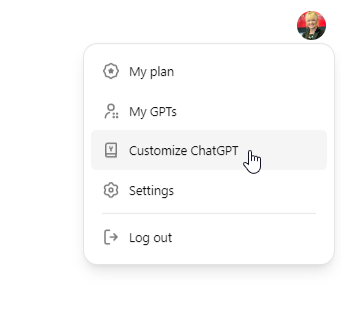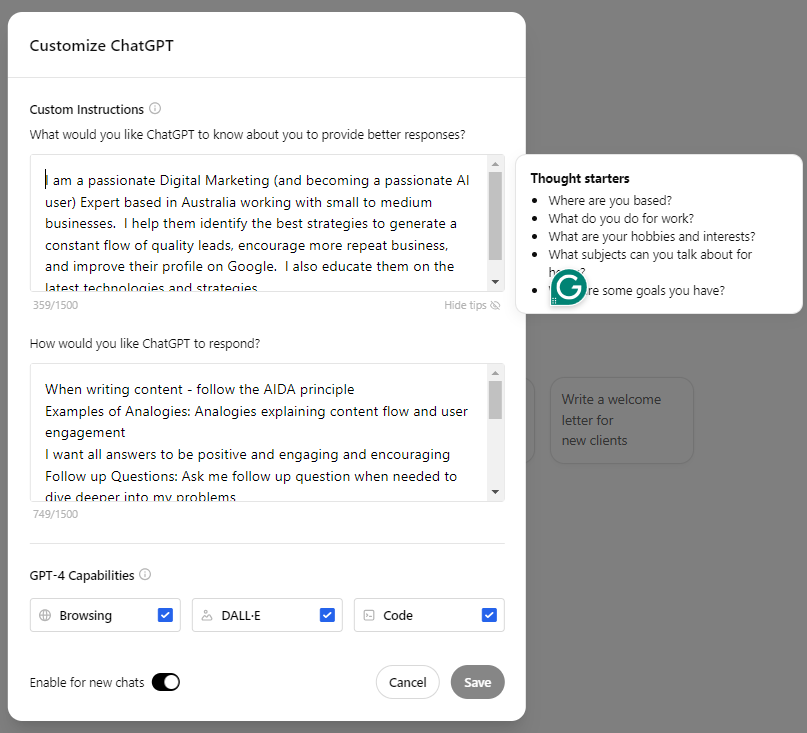Mastering ChatGPT Prompts

Artificial intelligence (AI) can significantly boost your business's efficiency and productivity. One of the most powerful tools available is ChatGPT, an AI language model capable of generating human-like text based on the prompts it receives. Whether you need creative writing suggestions, draft emails, or complex explanations, ChatGPT can assist with a wide range of tasks. However, to truly unlock its potential, mastering the art of crafting effective prompts is essential. This blog will guide you through the basics of prompting, provide tips on crafting clear and specific instructions, and explore different prompt structures to help you achieve the best results.
Understanding the Basics of Prompting
A prompt is the initial input or query you provide to ChatGPT to receive a response. The quality of the prompt directly impacts the relevance and accuracy of the response you receive. Clear and specific prompts reduce ambiguity, allowing ChatGPT to focus on the task without misinterpretation.
For instance, compare these two prompts:
Ambiguous: "Tell me about insurance."
Clear: "Explain the benefits of life insurance for young families."
The first prompt is open to broad interpretation, which might lead to a general and unfocused response. The second prompt is specific and directs ChatGPT to provide information relevant to a particular audience and context.
Crafting Clear and Specific Prompts
The importance of clarity in prompts cannot be overstated. When your instructions are clear, ChatGPT can more easily understand and fulfill your request. Here are some tips for crafting effective prompts:
Be Direct:
Avoid unnecessary words or complex phrasing. Get straight to the point.
Use Specific Terms
Instead of generic words, use terms that precisely describe your needs.
Limit Scope
Narro w the topic to a manageable size to prevent overly broad answers.
Example:
Instead of asking, "How does insurance work?" you might ask, "How does car insurance work in Hong Kong, and what are the common coverage options?"
Providing Context and Instructions
Context is crucial for obtaining accurate and helpful responses from ChatGPT. When you provide relevant details, constraints, or guidelines within your prompt, you help the model understand the specific environment or situation you are referring to. This can significantly improve the quality of the response.
For example, consider the prompt: "Write a marketing email." This is quite broad and could lead to a generic response. A context-rich version would be: "Write a marketing email to small business owners in the UK, promoting a new life insurance policy, highlighting benefits such as flexible payment options and comprehensive coverage."
Including such details helps ChatGPT tailor the response to your specific needs. Here are some tips for providing effective context:
Specify the Audience
Mention who the response is intended for.
Include Relevant Details
Add any information to help narrow the scope.
Set Constraints
Define any limitations or specific requirements.
Experimenting with Prompt Structures
Experimenting with different prompt structures can significantly impact the type and quality of responses you receive from ChatGPT. By varying how you frame your requests, you can guide the model to produce more detailed, accurate, and relevant outputs.
One practical approach is breaking down tasks into smaller, more manageable steps. For example, instead of asking, "How do I improve my website's SEO?" you could structure it as:
"What are the key elements of SEO?"
"How can I optimise my website's content for SEO?"
"What are some advanced SEO techniques for better search rankings?"
This step-by-step structure helps ChatGPT focus on each aspect individually, leading to more thorough and organised responses.
Encouraging Critical Thinking and Nuanced Responses
To encourage more profound analysis and answers from ChatGPT, it's essential to frame your prompts in a way that promotes thinking. This involves asking questions that require the model to evaluate, compare, or consider multiple aspects of a topic.
One effective strategy is to ask follow-up questions that build on initial responses. For example, after receiving a basic answer to "What are the benefits of life insurance?" you could follow up with, "Can you compare the benefits of life insurance for young families versus retirees?"
Creating scenarios can also promote critical thinking. For instance, "Imagine you are an insurance advisor. How would you explain the importance of life insurance to a sceptical client?" This type of prompt requires the model to adopt a specific perspective and consider how to communicate effectively.
Another tip is to ask for pros and cons or to evaluate different options. For example, "What are the advantages and disadvantages of term life insurance compared to whole life insurance?" This encourages a balanced analysis, leading to a more nuanced response.
Example ChatGPT Prompts
To demonstrate the application of the techniques discussed in this blog, here are two detailed examples of effective ChatGPT prompts
Prompt Example 1

Why this prompt is good:
Clarity and Specificity
The prompt is clear and direct, avoiding unnecessary words.
Context and Instructions
Provides details about the target audience and product.
Audience Specification
Ensures relevance by mentioning small business owners.
Relevant Details
Highlights specific benefits to focus the response.
Tone Guidance
Specifies a professional yet friendly tone.
Call-to-Action
Encourages engagement with a clear next step.
Prompt Example 2

Why this prompt is good:
Identity Assignment
Gives ChatGPT a clear role to adopt, framing the response professionally.
Clarity and Specificity
Clearly outlines the task and target audience.
Context and Instructions
Details specific aspects of SEO to be covered.
Audience Specification
Tailors content to the expertise level of small business owners.
Relevant Details
Ensures the guide is accessible and actionable.
Limiting Scope
Focuses on key elements to keep the content manageable.
Practical Tips
Emphasises useful and applicable advice.
Custom GPT vs Custom Instructions
When working with ChatGPT, you can use either Custom GPTs or Custom Instructions to tailor the model's behaviour and responses to better suit your needs. Understanding the differences between these two customisation options can help you choose the best approach for your specific use case.
Custom GPTs
Custom GPTs allow users to create entirely new versions of the model with specific training data and instructions. This process involves fine-tuning the base model on a curated dataset that aligns with your requirements. Custom GPTs are particularly useful for:
Specialised Knowledge
If you need the model to have deep expertise in a specific domain, such as legal advice or medical information, custom GPTs can be trained on relevant data to enhance accuracy and relevance.
Branded Tone and Style
For businesses and content creators, custom GPTs can be fine-tuned to match a particular tone, style, or voice, ensuring consistency across all interactions.
Unique Use Cases
Custom GPTs can be tailored for niche applications, such as generating technical documentation, creating educational content, or providing customer support in specialised industries.
Custom Instructions


Custom Instructions, on the other hand, are a more straightforward and quicker way to guide ChatGPT's behaviour without extensive retraining. This feature allows users to specify how they want the model to respond by setting specific parameters or instructions at the start of each interaction. Custom Instructions are ideal for:
Adjusting Tone and Formality
Users can instruct ChatGPT to adopt a specific tone, formal, casual, professional, or friendly, without fine-tuning the model.
Contextual Relevance
You can provide context or background information that the model should consider while generating responses. This ensures the outputs are more relevant to the specific situation or audience.
Task-Specific Guidance
Custom Instructions can guide the model in approaching particular tasks, such as summarising text, translating languages, or generating creative content.
Unlocking ChatGPT's Full Potential Using Good Prompting Skills
Mastering the art of crafting effective prompts is key to unlocking ChatGPT's full potential. By understanding the basics of prompting, crafting clear and specific instructions, and providing rich context, you can significantly improve the relevance and quality of the responses you receive. Experimenting with different prompt structures and encouraging critical thinking can further enhance the depth and usefulness of ChatGPT's outputs.
By honing these skills, you'll be better equipped to leverage ChatGPT for various tasks, making your interactions more productive and satisfying. Remember, practice and experimentation are essential to becoming proficient in prompt writing. So, start applying these techniques and watch your ChatGPT interactions transform.
| Tags:ChatGPT |

